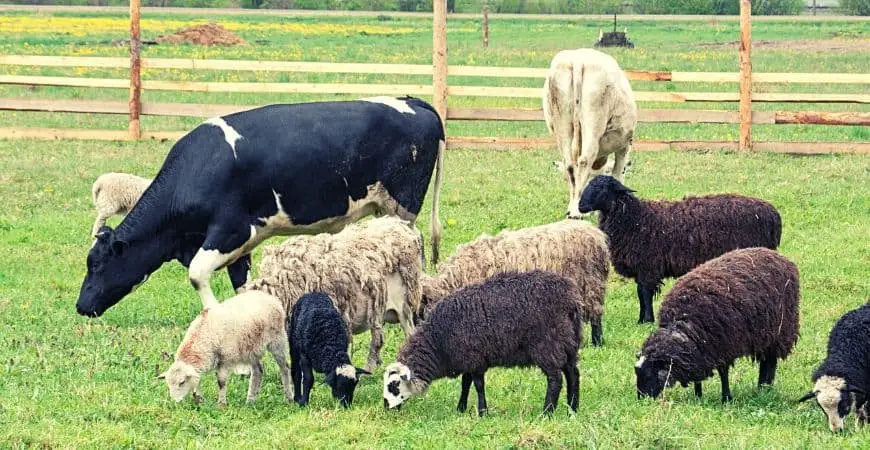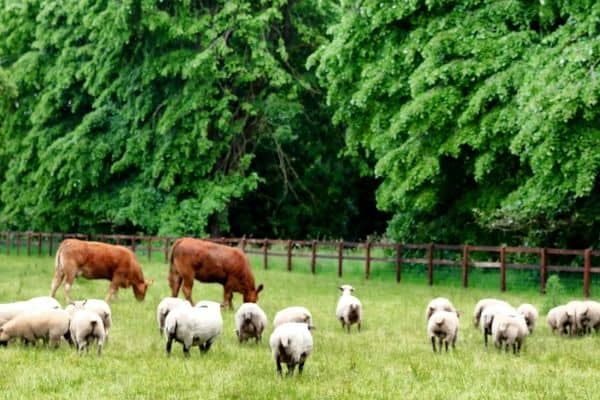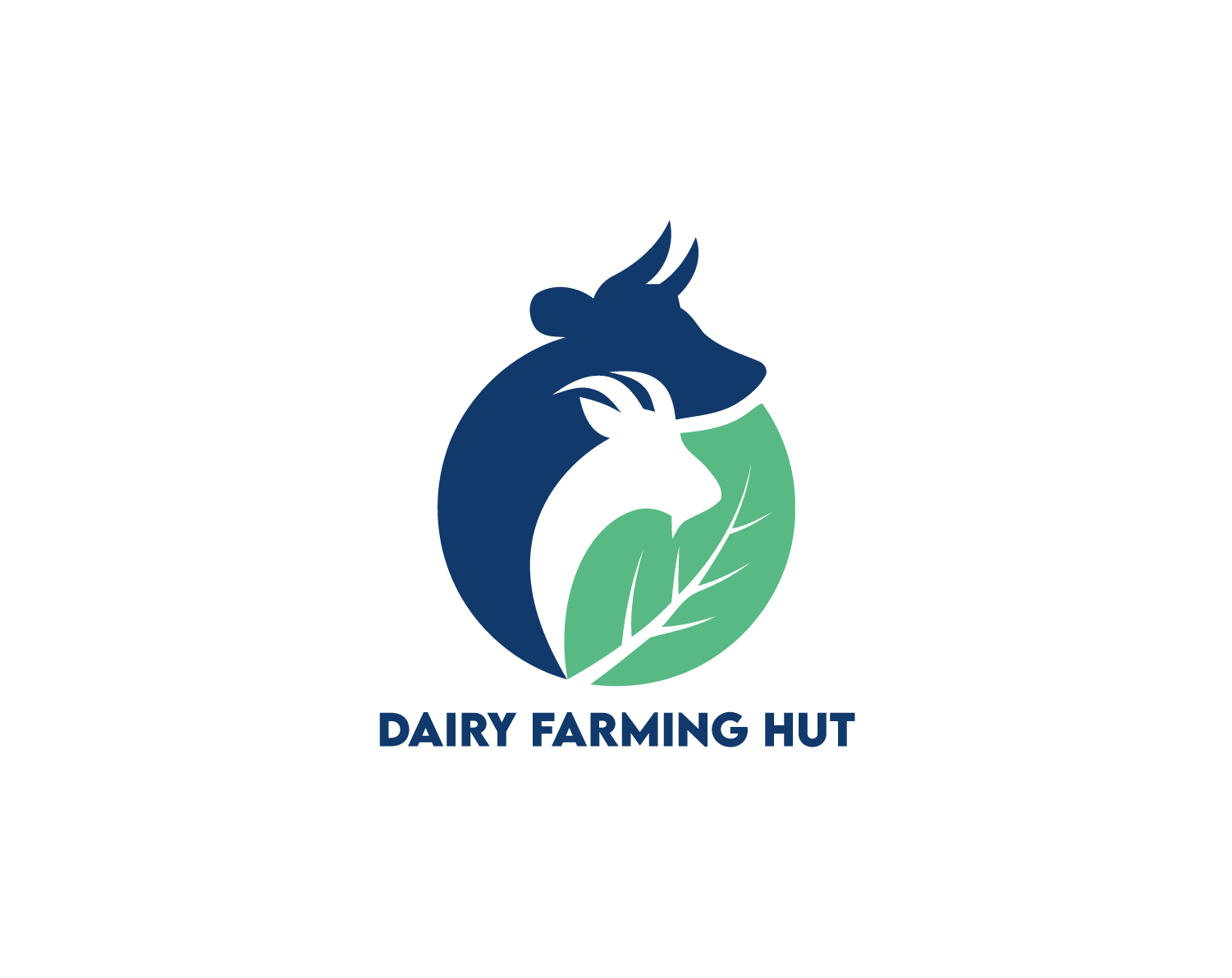Ranchers have pastured sheep and cows together for centuries. This ancient practice was discontinued over the last hundred years or so, due to the modernization of ranching practices. However, modern ranchers seeking to increase both field and livestock productivity are rediscovering the old secret that cattle and sheep pasture well together, given the right conditions.
The symbiotic relationship between a sheep and a cow is typified by foraging and parasite management. Cows graze grass and leave four inches above the soil. Sheep eat grass, forbs, and shrubbery down to the soil. Parasites are eaten by the wrong host and destroyed, aiding the health of both species.
There is a lot to consider when planning to pasture sheep and cows together. However, there are distinct benefits to a well-executed co-pasturing plan, and ranchers are rediscovering how to make it work. The efficient foraging increased meat production per acre and added protection for small ruminants make this relationship worth exploring for backyard farms and large ranching operations alike.
Concept of Multi-Species Grazing, or The Flerd

Mixing flocks and herds together is sometimes referred to as flerding or the flerd. This is a compound word made from flock and herd.
Multi-species grazing is another term that is often used when different livestock such as cattle and sheep are grazed together.
There are general groups of breeds of cows and sheep that flerd better together than others. This is a very general overview of the animals to consider placing in this symbiotic grazing situation.
Some Facts to Consider When Placing Cows and Sheep in Symbiotic Grazing
White-faced breeds of sheep naturally tend to herd more closely than black-faced species. This means that they also can be trained more readily to flerd with cattle and not wander off unprotected
Research has shown that most cattle species are docile enough to tolerate grazing with sheep and to bond with them relatively quickly, given the right conditions.
Guard dogs have proven to be an effective protection for both sheep and cattle in a bonded flerding situation, with no sheep fencing needed.
What are the Benefits of Multispecies Grazing For the Pasture?
Today’s researchers and ranchers are actively looking for ways to increase wise stewardship of the limited land resources available. This includes exploring ways to steward livestock on this land in a way that results in better livestock production without depleting soil and water resources.
The old ways of multi-species grazing are being rediscovered as one of the best ways to graze and restore forage lands efficiently.

There are many reasons why sheep and cattle graze well together, the first reason being foraging. The diets of sheep and cattle overlap, but they are not identical. Both species enjoy grasses but eat them differently.
This symbiosis can break down when the forage is not in high enough quantity to be grazed twice. Both cattle and sheep can handle some resource competition and thrive but need to be consistently monitored.
Looking for Shearing Machine for your Goats?
Check best Sheep Shearing Machines under $200
Key Things to Observe while Cattle and Sheep Graze Together
When pastured together, meat production per acre is maximized with the available forage, and the grass is enabled to grow back thicker than if cattle are pastured alone. The dietary overlap and meat or offspring production gains are different in every area, depending on the forage in the region.
However, studies from many different regions show that acreage tends to produce more, and both cattle and sheep are healthier and perform better when grazed together.
What are the Types of Multi-Species Grazing?
Multi-species grazing can be divided in two sub categories:
- 1Separated Grazing
- 2Flerding
1. Separated Grazing
One way that ranchers seek to benefit from multi-species grazing is by exercising field rotation with both the herd of cattle and the flock of sheep while still keeping them separated. In this strategy, the cattle are allowed to thoroughly graze the range first, and then they are moved out into a new pasture.
The flock of sheep is then allowed to come and finish the pasture, nibbling pasture grass to the ground and clearing more weeds and forbs than the cattle will eat. The sheep grazing ensures efficient pasturing as they finish off what the cattle left behind. They also help to finish pushing organic matter into the soil to decompose and fertilize the land.
Finally, the sheep are moved out as well, and the pasture is left to sit and regrow. There are pros and cons to this type of multi-species grazing.
Pros
Cons
2. Flerding
The second type of multi-species grazing is flerding or putting both the flock of sheep and the herd of cattle together in the pasture at the same time.
Some aspects of this approach to co-grazing have already been covered.
For comparison, here are some of the pros and cons of this method of multi-species grazing.
Pros
Cons
Benefit of Multi-Species Grazing in Parasite Control
Sheep and cattle do not suffer from the same parasitic infections. Sheep are more likely to contract parasites due to the way they eat, clipping grass, forbs, and shrubs to the soil where parasites live, waiting to be consumed by a host.
Main Benefits:
All of this means that ranchers and backyard farmers alike will spend less time and money on antiparasitic treatments for the flerd than they will by grazing each species alone. Also, the increase in health for each member of the flerd will result in greater productivity, cost savings, and ultimately higher income from the operation.
How to Prepare Sheep and Cattle for Multi-Species Grazing?
Both sheep and cattle must be bonded with each other to make this type of grazing work. Whether you are looking to raise three sheep with one cow or 500 sheep with 100 cows, this bonding must take place first. Also, the pasture and water sources must be set up in advance to ensure success and limit adverse outcomes as much as possible.
Best Way to Promote Bonding Between Cows and Sheep
Bonding works best with lambs. Pen the young lambs with a few heifers, depending on the pen space you have, and allow them to live together for 30 days. Watch for harmful interactions, and provide a safe space for sheep to escape to if they feel threatened or need to get away from the larger animals. Some studies have shown that bonding can be accomplished in as little as 15 days, but a longer time is better.
Alternatively, ewes can raise lambs in the pasture with the cattle. This is a little riskier for the lambs, but it works well with enough space and predator protection. Lambs will typically not actively bond with cattle until they are weaned, so it will be months before they begin to effectively bond and become a committed part of the flerd.
Benefits That Cows Provide For Sheep
As far as a symbiotic relationship goes, this one is more one-sided as far as direct benefits to the animals. The sheep receive much more active benefit than they give, but it is impossible to know all of the assistance that each species may receive from the other.
Sheep are naturally quite docile, meek, and gentle animals. They are very vulnerable to attacks from predators such as:
- Cougars
- Wolves
- Coyotes
- Feral dogs
- Foxes
- Feral pigs
These predators will snatch a lamb whenever possible, but large ewes are also extremely vulnerable, especially to dog-sized and larger predators. They tend to run and get lost and separated from the herd rather than mounting a counter-attack for protection.
Ranchers lose a large number of sheep from herds every year. Predators are a huge problem and seemingly the most significant problem that is solved by flerding.
Cattle are larger animals and much more aggressive toward attackers. When sheep are mixed in with cattle, and a coyote begins hunting, the cattle mount an effective counter-attack that discourages further small-predator hunting. When the rancher adds a guard dog or two, the sheep are very safe grazing with cattle.
Sheep are prone to wander and become lost or wander into pastures where they do not belong. Once lost, they require retrieval. This is why shepherds employ the help of trained sheepdogs and guard dogs of various breeds. Sheep that are flerding with cattle will stay very close to the cattle and call wanderers back to the group.
Benefits That Sheep Provide for Cows
The main benefit for cattle in a flerd comes from the increased quality and quantity of pasture forage. This is a vital benefit too, and one that ranchers constantly seek to achieve with seeding, watering, soil amendment, and grazing rotation.
Sheep are well-known for increasing the quality of pasture forage very fast. Some ranchers use sheep grazing during certain years to improve the quality of dairy cattle fields.
As the sheep eat the forbs, weeds, and scrub, the land is made more productive in denser, high-quality grasses.
This clearing also aids the rancher who plans to transition from native forage to planted grasses gradually.
Because the sheep prefer to eat shorter grasses and weeds that cattle do not eat, including grasses around manure piles, the sheep can graze alongside cattle without getting too much in the way. They are more comfortable going in to eat after the cows have passed through and shortened the grasses.
The final benefit is parasite control, which both species unknowingly do for each other. This is an excellent health enhancement for sheep and cows and a time and money saver for the rancher.
Conclusion
Many studies and anecdotal evidence have shown that cattle and sheep graze well together, and tend to live contentedly alongside each other, provided that they have been intentionally bonded together as symbiotic species. While this arrangement does require more planning ahead of time with fencing and bonding lambs with heifers, it saves time and money later on and results in more monetary production per acre.
Ranchers in previous generations knew all about the symbiosis that can be attained not just between sheep and cows but between all kinds of livestock animals. While ranching has gone through extreme specialization and this kind of multi-species livestock raising has not been the norm for some decades, it is being rediscovered by researchers and ranchers who seek to maximize stewardship of grazing lands.
Sources:
https://www.beefmagazine.com/pasture/sheep-cattle-combination-really-works
https://agricsite.com/can-cows-and-sheep-live-together/
https://u.osu.edu/sheep/2020/03/10/pasture-species-selection-for-sheep/
http://www.beefresearch.ca/research-topic.cfm/forage-species-106
https://ucanr.edu/blogs/blogcore/postdetail.cfm?postnum=27009
https://www.sciencedirect.com/science/article/abs/pii/0168159187901985
